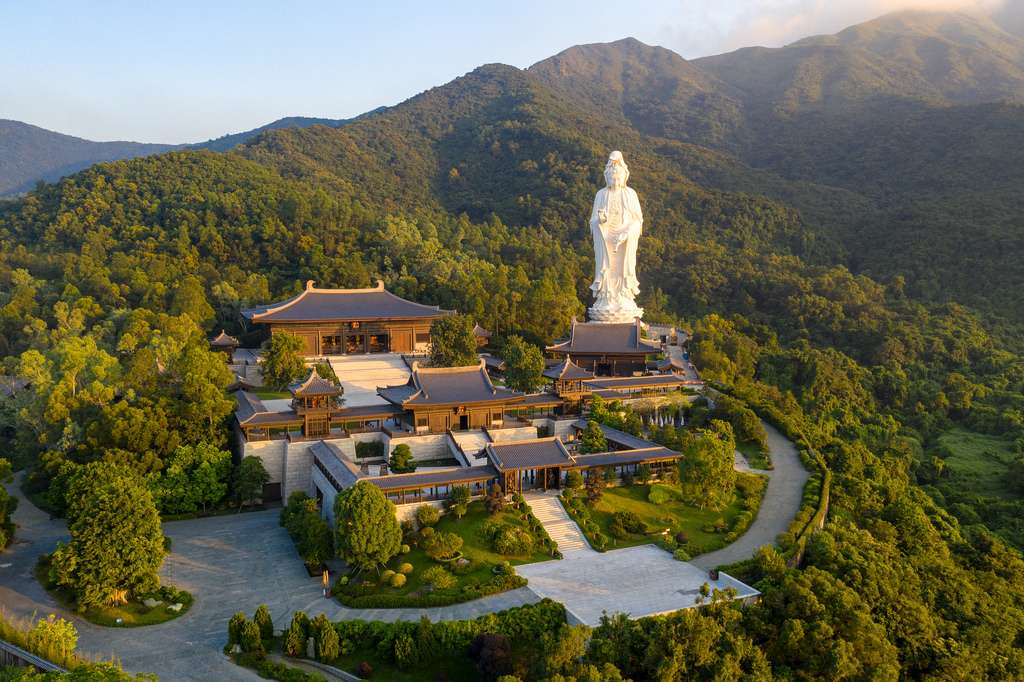
Hong Kong unveiled its first Buddhist Art Museum this week at the Tsz Shan Monastery in Tai Po.
Hong Kong’s richest citizen, Li Ka-shing, now a 90-year-old billionaire, conceived of the monastery in 2003. It opened in 2015 after over 10 years of construction, nestled in the verdant green hills of northern Hong Kong beneath the watchful eye of a massive 249-foot-tall bronze statue of Guanyin, goddess of mercy.
“The museum aspires to promulgate Buddhist teachings, guiding our visitors in their journeys of appreciation of Buddhist art, thereby welcoming them to lead a purified, purposeful life,” reads the institution’s mission statement.
The 24,000-square-foot museum sits at the foot of the statue and cost nearly $400 million to build, according to Cai Xing Global. It features 100 Buddhist statues and 43 handwritten Dunhuang sutras. The collection was put together based on advice from a committee of experts in Buddhist culture. The works were either donated by Li or purchased by his eponymous foundation, which he began in 1980.
“The invaluable collection of Buddhist statues, paintings, carvings, and sutras housed in the Tsz Shan Monastery Buddhist Art Museum represent not only the enlightened ideals and cultural sphere of Zen Buddhism, but will also provide a base for cultural programs and activities,” said Carrie Lam, Hong Kong’s chief executive, in a statement. “The visual and literary culture of the monastery and its museum will no doubt serve as a quiet space for reflection and the appreciation of Buddhist art for our citizens and visitors.”
Inaugurated on Wednesday in a ceremony with 2,000 guests, the museum welcomes the public beginning May 1. Admission to the institution is free but requires advance reservations. Since opening in April 2015, the monastery has welcomed some 1 million visitors.
See more photos from the monastery and the art museum collection below.
Li Ka-shing at the unveiling of Tsz Shan Monastery’s Buddhist Art Museum. Photo courtesy of CK Hutchison Holdings Limited.
Li Ka-shing at the unveiling of Tsz Shan Monastery’s Buddhist Art Museum with a Seated Buddha Protected by the Nāga King from Cambodia Khmer Empire (circa 12th to 13th century). Photo courtesy of CK Hutchison Holdings Limited.
Head of Buddha with Regal Crown, China Ming dynasty (15th century). Photo courtesy of the Tsz Shan Monastery’s Buddhist Art Museum.
An artwork from the Tsz Shan Monastery’s Buddhist Art Museum. Photo courtesy of the Tsz Shan Monastery’s Buddhist Art Museum.
An artwork from the Tsz Shan Monastery’s Buddhist Art Museum. Photo courtesy of the Tsz Shan Monastery’s Buddhist Art Museum.
Statues at Tsz Shan Monastery in Hong Kong. Photo by Franke Tsang/South China Morning Post/Getty Images.
Statues at Tsz Shan Monastery in Hong Kong. Photo by Franke Tsang/South China Morning Post/Getty Images.
A statue at Tsz Shan Monastery in Hong Kong. Photo by Franke Tsang/South China Morning Post/Getty Images.
Pensive Bodhisattva, China Northern Qi dynasty (circa 550–577), from the collection of the Tsz Shan Monastery’s Buddhist Art Museum. Photo courtesy of CK Hutchison Holdings Limited.
Gilt bronze seated Luohan, China Ming dynasty (first half of the 15th century), from the collection of the Tsz Shan Monastery’s Buddhist Art Museum. Photo courtesy of CK Hutchison Holdings Limited.
Bust of Buddha, China Northern Qi dynasty (circa 550–577), from the collection of the Tsz Shan Monastery’s Buddhist Art Museum. Photo courtesy of the Tsz Shan Monastery’s Buddhist Art Museum.
Statues at Tsz Shan Monastery in Hong Kong. Photo by Franke Tsang/South China Morning Post/Getty Images.
Seated Guanyin Bodhisattva, China Liao dynasty (circa 916–1125) from the collection of the Tsz Shan Monastery’s Buddhist Art Museum. Photo courtesy of CK Hutchison Holdings Limited.
The 249-foot-tall statue of Goddess Guanyin at Tsz Shan Monastery. Photo by Zhang Wei/China News Service/VCG/Getty Images.